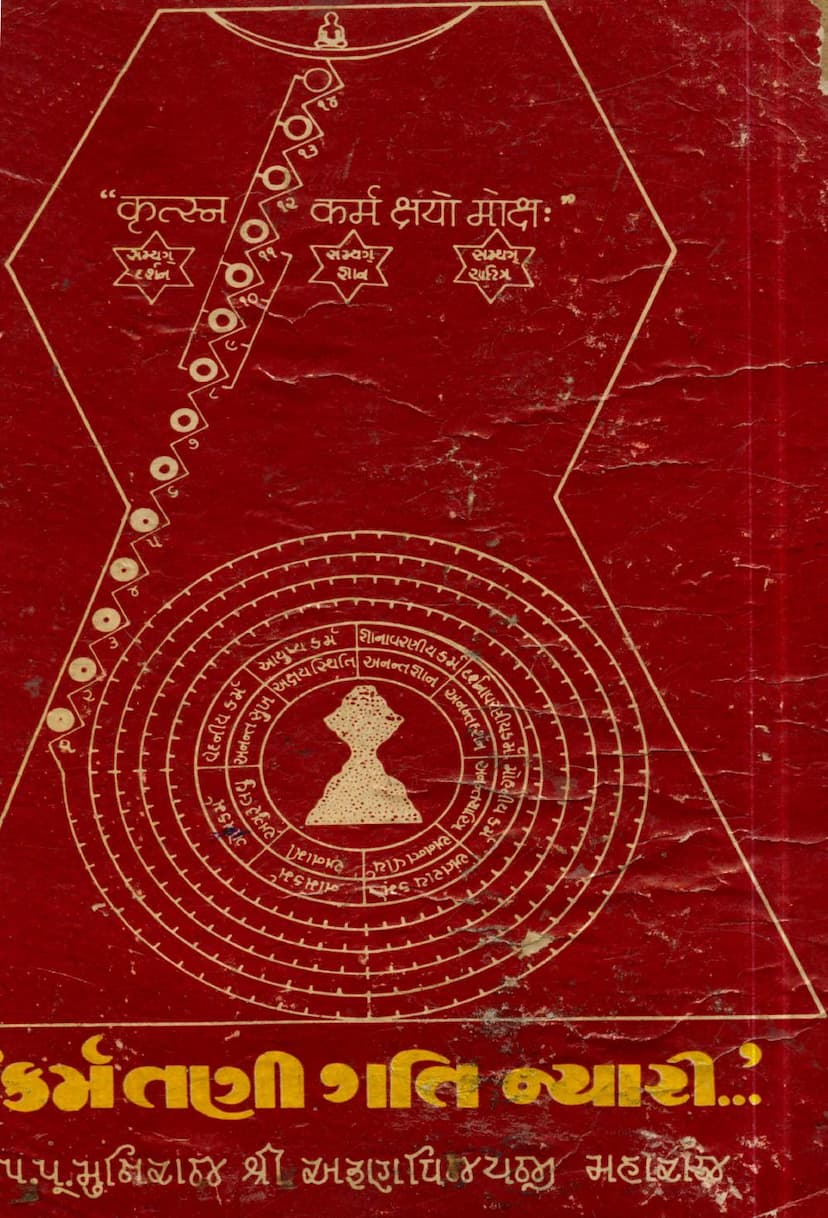Karm Tani Gati Nyari
Added to library: September 2, 2025

Summary
Here's a comprehensive summary of the Jain text "Karm Tani Gati Nyari" by Arunvijay, based on the provided pages:
Title: Karm Tani Gt Nyari (The Subtle Nature of Karma) Author: Muni Arunvijayji Maharaj Publisher: N. M. Vadi Gopipura Surat Compiled by: Kapilray Nanalal Thaker
This book is a compilation of a series of public lectures on the topic of Karma delivered by the revered Muni Arunvijayji Maharaj in Surat during his Chaturmas (a four-month monastic retreat) in 1982. The lectures were organized by the Shri Mahavir Vidyarthi Kalyan Kendra, Mumbai, and were widely appreciated, with published booklets distributed weekly. The book aims to explain the intricate Jain philosophy of Karma in a simple, illustrative, and engaging manner to the general public.
Core Themes and Concepts:
The central theme of the book revolves around Karma in Jainism, explaining its fundamental principles, its workings, and its impact on the soul's journey through the cycle of birth and death (Samsara). The lectures delve into:
- The Nature of Karma: The book emphasizes that "Karm tani gati nyari" – the nature and movement of karma are subtle and unique. It asserts that karma is the primary reason for the disparities observed in the world, such as differences in wealth, status, happiness, and suffering.
- Karma and the Soul: It explains how the soul (Atma) is intrinsically pure and possesses infinite knowledge, perception, power, and bliss. However, these qualities are veiled by karmic particles that attach to the soul due to its actions driven by passions (kashayas) like desire and anger.
- The Cycle of Samsara: The soul's perpetual cycle of birth, death, and rebirth across various life forms and realms (heavenly, human, animal, and hellish) is attributed to the bondage of karma. The soul is described as endlessly revolving in this cycle, like an ox in an oil mill, driven by karma.
- The Eight Types of Karma: The book systematically explains the eight primary types of karma (Ashtakarma) and their specific functions, illustrating their effects on the soul's qualities and worldly experiences:
- Gyanavarniya Karma (Knowledge-obscuring Karma): Veils the soul's inherent knowledge.
- Darshanavarniya Karma (Perception-obscuring Karma): Veils the soul's inherent perception.
- Mohaniya Karma (Delusion-inducing Karma): Causes attachment, aversion, passions, and ignorance, leading to wrong views and behavior.
- Antaraya Karma (Obstructing Karma): Hinders the soul's inherent abilities like giving, gaining, enjoying, and possessing.
- Vedaniya Karma (Feeling-inducing Karma): Causes experiences of pleasure (shata) and pain (ashata).
- Namkarma (Name Karma): Determines the physical form, body structure, senses, and other physical attributes.
- Gotrakarma (Status Karma): Influences the soul's birth into higher or lower families and social strata.
- Ayushyakarma (Lifespan Karma): Determines the duration of life in a particular body and realm.
- The Law of Cause and Effect: The fundamental principle of karma is explained through the concept of "as you sow, so shall you reap." Every action has a consequence, and these consequences are not meted out by an external God but are inherent in the nature of karma itself.
- The Purpose of Jain Philosophy: The ultimate goal of understanding karma is to break free from the cycle of Samsara and achieve Moksha (liberation). This is achieved by shedding karmic bondage through right faith (Samyak Darshan), right knowledge (Samyak Gyan), and right conduct (Samyak Charitra).
- Path to Liberation: The lectures guide the audience on how to understand karma's workings, detach from worldly desires and passions, and cultivate virtues like compassion, non-violence, forgiveness, and austerity to purify the soul and attain liberation.
- Illustrative Examples: The lectures are enriched with numerous stories and examples from Jain scriptures and history, such as those of King Shrenik, Queen Sulsa, King Nala and Damayanti, and Lord Mahavir himself, to make the complex concepts relatable and understandable.
- The Importance of Right Faith (Samyak Darshan): The book highlights that right faith in the Tattvas (realities) and the teachings of the omniscient Tirthankaras is the crucial first step towards liberation.
- The Nature of the Soul: The soul is described as inherently pure, possessing infinite knowledge, perception, bliss, and power, but these are obscured by karma. The aim of spiritual practice is to remove these veils and realize the soul's true nature.
- The Role of Knowledge: Different types of knowledge (Mati, Shruta, Avadhi, Manahparyav, Keval) are explained, emphasizing that true knowledge is essential for understanding the self and the nature of reality, leading to liberation.
- The Concept of Moksha: Moksha is presented as the ultimate state of liberation from the cycle of birth and death, characterized by infinite bliss, knowledge, and purity, where the soul resides eternally in its pure form.
Key Takeaways:
The lectures convey a profound message:
- Individual Responsibility: Each soul is responsible for its own karmic bondage and liberation. There is no external divine intervention in the karmic process.
- The Power of Action: Actions (karma) have direct consequences. Even hidden actions are recorded by karma.
- The Goal of Life: The ultimate purpose of life is to purify the soul from karmic impurities and attain Moksha.
- Practical Guidance: The book offers practical insights into how to live a life that minimizes karmic bondage and promotes spiritual progress through ethical conduct, self-discipline, and devotion.
In essence, "Karm Tani Gati Nyari" serves as a comprehensive and accessible guide to understanding the doctrine of karma within Jainism, offering spiritual guidance and a path towards self-realization and liberation.